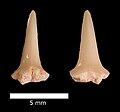
The Lamniformes are an order of sharks commonly known as mackerel sharks. It includes some of the most familiar species of sharks, such as the great white, as well as more unusual representatives, such as the goblin shark and megamouth shark.

The Chalk Group is the lithostratigraphic unit which contains the Upper Cretaceous limestone succession in southern and eastern England. The same or similar rock sequences occur across the wider northwest European chalk 'province'. It is characterised by thick deposits of chalk, a soft porous white limestone, deposited in a marine environment.

Squalicorax is a genus of extinct lamniform shark known to have lived during the Cretaceous period.
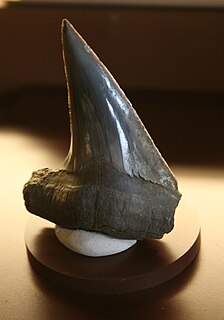
Cretoxyrhina is an extinct genus of large mackerel shark that lived about 107 to 73 million years ago during the late Albian to late Campanian of the Late Cretaceous period. The type species, C. mantelli, is more commonly referred to as the Ginsu shark, first popularized in reference to the Ginsu knife, as its theoretical feeding mechanism is often compared with the "slicing and dicing" when one uses the knife. Cretoxyrhina is traditionally classified as the likely sole member of the family Cretoxyrhinidae but other taxonomic placements have been proposed, such as within the Alopiidae and Lamnidae.

Xiphactinus is an extinct genus of large predatory marine bony fish that lived during the Late Cretaceous. When alive, the fish would have resembled a gargantuan, fanged tarpon. The species Portheus molossus described by Cope is a junior synonym of X. audax. Skeletal remains of Xiphactinus have come from the Carlile Shale and Greenhorn Limestone of Kansas, and Cretaceous formations all over the East Coast in the United States, as well as Europe, Australia, the Kanguk and Ashville Formations of Canada,, La Luna Formation of Venezuela and the Salamanca Formation in Argentina.
Tylosaurus was a mosasaur, a large, predatory marine reptile closely related to modern monitor lizards and to snakes, from the Late Cretaceous.
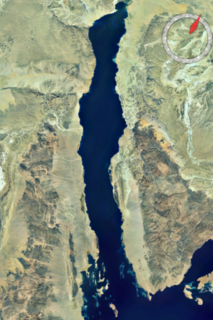
The Gulf of Suez Rift is a continental rift zone that was active between the Late Oligocene and the end of the Miocene. It represented a continuation of the Red Sea Rift until break-up occurred in the middle Miocene, with most of the displacement on the newly developed Red Sea spreading centre being accommodated by the Dead Sea Transform. During its brief post-rift history, the deepest part of the remnant rift topography has been filled by the sea, creating the Gulf of Suez.
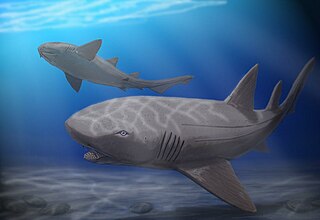
Ptychodus is a genus of extinct hybodontiform sharks. As well as a genus of durophagous (shell-crushing) sharks from the Late Cretaceous. Fossils of Ptychodus teeth are found in many Late Cretaceous marine sediments. There are many species among the Ptychodus that have been uncovered on all the continents around the globe. Such species are Ptychodus mortoni, P. decurrens, P. marginalis, P. mammillaris, P. rugosus and P. latissimus to name a few. They died out approximately 85 million years ago in the Western Interior Sea, where a majority of them were found. A recent publication found that Ptychodus are classified as neoselachian versus hybodont or batoid.

During the time of the deposition of the Niobrara Chalk, much life inhabited the seas of the Western Interior Seaway. By this time in the Late Cretaceous many new lifeforms appeared such as mosasaurs, which were to be some of the last of the aquatic lifeforms to evolve before the end of the Mesozoic. Life of the Niobrara Chalk is comparable to that of the Dakota Formation, although the Dakota Formation, which was deposited during the Cenomanian, predates the chalk by about 10 million years.

Cardabiodon is an extinct genus of large mackerel shark that lived about 95 to 91 million years ago (Ma) during the Cenomanian to Turonian of the Late Cretaceous. It is a member of the Cardabiodontidae, a family unique among mackerel sharks due to differing dental structures, and contains the two species C. ricki and C. venator. Cardabiodon fossils have been found in Australia, North America, England, and Kazakhstan. It was likely an antitropical shark that inhabited temperate neritic and offshore oceans between 40° and 60° paleolatitude, similar to the modern porbeagle shark.

Cretalamna is a genus of extinct otodontid shark that lived from the Late Cretaceous to Eocene epoch. It is considered by many to be the ancestor of the largest sharks to have ever lived, Carcharocles angustidens, and Carcharocles megalodon.
The Pen Formation is a Campanian-age geologic unit in the western United States.
The geology of Israel includes igneous and metamorphic crystalline basement rocks from the Precambrian overlain by a lengthy sequence of sedimentary rocks extending up to the Pleistocene and overlain with alluvium, sand dunes and playa deposits.
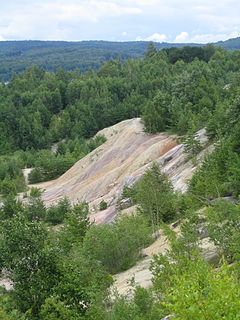
The Kristianstad Basin is a Cretaceous-age structural basin and geological formation in northeastern Skåne, the southernmost province of Sweden. The basin extends from Hanöbukten, a bay in the Baltic Sea, in the east to the town of Hässleholm in the west and ends with the two horsts Linderödsåsen and Nävlingeåsen in the south. The basin's northern boundary is more diffuse and there are several outlying portions of Cretaceous-age sediments. During the Cretaceous, the region was a shallow subtropical to temperate inland sea and archipelago.
Thalassinoides burrowing system throughout the Menuha Formation chalk.
Cretalamna appendiculata tooth, Menuha Formation.
Squalicorax kaupi tooth, Menuha Formation.
Squalicorax falcatus? tooth, Menuha Formation.
Carcharias samhammeri tooth, Menuha Formation.
Carcharias cf. C holmdelensis tooth, Menuha Formation.
Cretoxyrhina mantelli tooth, Menuha Formation.
Scapanorhynchus rapax tooth, Menuha Formation.
Scapanorhynchus raphiodon? tooth, Menuha Formation.
Hadrodus priscus tooth, Menuha Formation.
Micropycnodon kansasensis? tooth, Menuha Formation.
Several foraminiferans replaced by silica from the Menuha Formation.
Several oysters, possibly Pycnodonte vesicularis, from the Menuha Formation.
Irregular echinoid spine from the chalk sediments of the Menuha Formation.
Menuha Formation and capping Mishash Formation south of
Makhtesh Ramon.



















